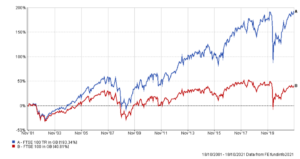
The rising cost of care has been hitting the headlines lately, which has placed the spotlight on long-term care annuities designed to pay out for the rest of a person’s life. But these annuities may not be the best solution for everyone.
The costs of long-term care are increasing. According to LaingBuisson, an independent provider of healthcare statistics, the average cost of residential care home fees for someone in the UK increased to £672 a week (almost £35,000 a year) in the 2019-2020 tax year, an increase of 3.0% on the average fees in the previous tax year. Over the same period, the costs associated with nursing homes – where residents receive round-the-clock care – reached an average of £937 per week, almost £49,000 a year, an uptick of 5%.
Despite recent announcements from the government that National Insurance and Dividend Tax will be increasing to help to pay for the cost of social care, most people will have to pay for their own care as they get older. And with around one-fifth of the UK population – or 12.3 million people – aged 65 or older (figures published in 2019), it’s not surprising that more people are considering taking out some sort of insurance policy to help pay the future costs of care. These products are also known as ‘long-term care annuity’ or ‘immediate needs annuity’. With both, you use a lump sum to buy an insurance policy that pays out a regular lifetime income. This income is then yours to help fund your care fees for as long as you live. While a long-term care annuity might seem like an appealing option, giving you some much-needed peace of mind, they have several limitations that everyone should be aware of before they take one out.
What types of long-term care annuities are available?
Broadly speaking, there are two options when it comes to the types of long-term care annuities currently available, depending on whether you need care funding now, or expect to need to fund care in the future. The first is an ‘immediate needs’ annuity, and the second is a ‘deferred annuity’. We explore both of these in a bit more depth below.
An immediate needs annuity
This is an insurance policy designed to pay a regular income towards the cost of your care fees over the course of your lifetime. An immediate needs annuity is usually considered appropriate if the individual has health issues or is already receiving care at home or in a care home.
The annuity is bought upfront, with a single payment. The amount you must pay to buy the annuity will be calculated based on factors such as your age, your health, and the expected costs of current and future care. If you’re in poor health, you can expect to pay a lower price for the annuity, given the length of time you will need to pay for care will most likely be shorter than for someone in good health.
Disadvantages of an immediate needs annuity
There are several drawbacks that mean immediate needs annuities may not offer the best value to someone in need of long-term care. For starters, the initial cost of the annuity can be staggering, and can eat up much of an individual’s capital assets. Whilst the average stay in care is 26 months, sadly many survive for a much shorter period of time in care, and in these cases, the return on the annuity purchased can prove to be very poor value. Usually, if an individual dies shortly after taking out an immediate needs annuity, there is no return of capital to the estate, leaving beneficiaries in the will significantly worse off.
Second, taking out an immediate needs annuity can take longer than the name would have you believe. As annuities are insurance policies, they have to be underwritten, which means the annuity provider will first collect information about your health from your GP, family and current care provider. Third, if your annuity doesn’t allow for care fee increases, it may not even cover all of your future care costs. If this happens, you will have to make up the shortfall through other means.
A deferred annuity
A deferred annuity is similar to an immediate needs annuity, although having bought the annuity, you won’t begin to receive the income payments immediately. Instead, you choose when you want to be paid income, usually between one and five years in the future. The longer the deferred period, the lower the cost of the plan overall.
The disadvantages of a deferred annuity
As you would expect, while cheaper than an immediate needs annuity, a deferred annuity still requires an upfront payment. Should you need to pay for care fees sooner than anticipated, you’ll be expected to pay these fees until the deferred annuity income starts. The worst-case scenario would be that care costs increased to levels that saw you run out of money before the deferred annuity kicks in.
It’s also worth noting that the income from your annuity will be taxed at your marginal rate and may also affect your entitlement to means-tested benefits. This applies to immediate needs annuities too.
Are long-term care annuities value for money?
The answer to this question really depends on the particular circumstances of the person who is in need of care. We would suggest that the number of people who would benefit from a long-term care annuity is actually rather small, and that it’s a specialist product for those with urgent care needs, and where leaving behind an estate is not a key factor. For the vast majority of people looking to make long-term care plans, other options might offer better value and suit their longer term objectives.
For example, instead of using capital to buy an annuity to pay for care, we often suggest an alternative where funds remain invested and capital is drawn down when required. This is a more flexible approach, and gives your money the chance to keep growing while it’s not needed. The added benefit of this is that upon death, the remaining capital is still available to form part of a person’s estate, and therefore left to beneficiaries.
If you are interested in discussing long-term care arrangements with one of our experienced financial planners at FAS, please get in touch here.
This content is for information purposes only. It does not constitute investment advice or financial advice.









